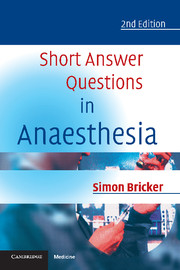Book contents
- Frontmatter
- Contents
- Preface
- Preface to the 1st edition
- Abbreviations
- 1 Advice on answering short answer questions
- 2 General Anaesthesia
- 3 Anaesthesia and Medical Disease
- 4 Medicine and Intensive Care
- 5 Obstetric Anaesthesia and Analgesia
- 6 Paediatric Anaesthesia
- 7 Neuroanaesthesia
- 8 Acute and Chronic Pain
- 9 Trauma and Emergency Anaesthesia
- 10 Anatomy, Applied Anatomy and Regional Anaesthesia
- 11 Pharmacology and Applied Pharmacology
- 12 Clinical Measurement and Equipment
- 13 Cardiac and Thoracic Anaesthesia
- Index
6 - Paediatric Anaesthesia
Published online by Cambridge University Press: 05 February 2014
- Frontmatter
- Contents
- Preface
- Preface to the 1st edition
- Abbreviations
- 1 Advice on answering short answer questions
- 2 General Anaesthesia
- 3 Anaesthesia and Medical Disease
- 4 Medicine and Intensive Care
- 5 Obstetric Anaesthesia and Analgesia
- 6 Paediatric Anaesthesia
- 7 Neuroanaesthesia
- 8 Acute and Chronic Pain
- 9 Trauma and Emergency Anaesthesia
- 10 Anatomy, Applied Anatomy and Regional Anaesthesia
- 11 Pharmacology and Applied Pharmacology
- 12 Clinical Measurement and Equipment
- 13 Cardiac and Thoracic Anaesthesia
- Index
Summary
How does the physiology of an infant aged 6 months differ from that of an adult?
This is a standard question which is orientated towards basic science and which aims to test your understanding of the important physiological differences in paediatric patients.
Introduction
Anatomical and physiological differences between adults and children are most marked at birth and converge with increasing age. At 6 months of age the physiological differences are best described by reference to the individual systems.
Surface area to mass ratio
The smaller the child the larger is the ratio of surface area to mass. This is probably the most important single factor and it explains a number of the physiological differences.
Alarge surface area is associated with increased heat loss, and all infants are at greater risk than adults or larger children of hypothermia.
The need to maintain body temperature via heat production results in a higher metabolic rate and higher tissue oxygen demand. Desaturation occurs quicker.
The higher BMR is associated with higher resting heart and respiratory rates.
Cardiovascular
In the cardiovascular system the capacity of the heart to increase cardiac output by increasing stroke volume is limited. Cardiac output increases predominantly by increasing heart rate.
The limbs are smaller in relation to the body. This means that there is less blood volume to mobilise from the periphery in response to hypovolaemia. Infants have less reserve.
- Type
- Chapter
- Information
- Short Answer Questions in Anaesthesia , pp. 177 - 202Publisher: Cambridge University PressPrint publication year: 2002



